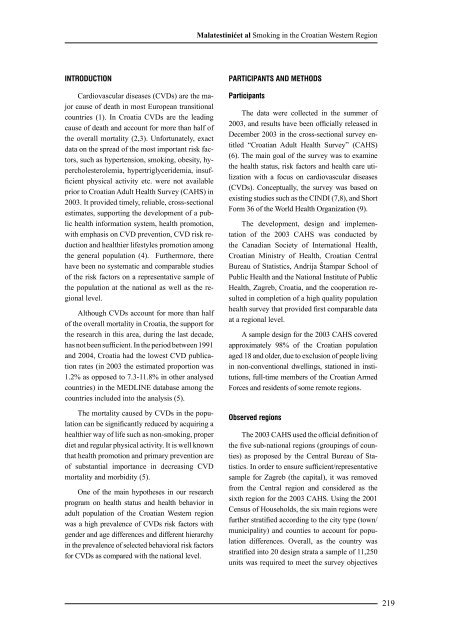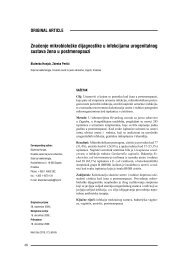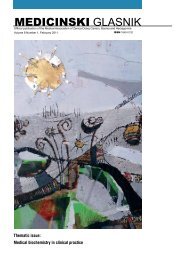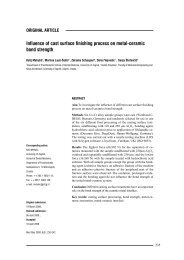MEDICINSKI GLASNIK
MEDICINSKI GLASNIK
MEDICINSKI GLASNIK
Create successful ePaper yourself
Turn your PDF publications into a flip-book with our unique Google optimized e-Paper software.
INTRODUCTION<br />
Cardiovascular diseases (CVDs) are the major<br />
cause of death in most European transitional<br />
countries (1). In Croatia CVDs are the leading<br />
cause of death and account for more than half of<br />
the overall mortality (2,3). Unfortunately, exact<br />
data on the spread of the most important risk factors,<br />
such as hypertension, smoking, obesity, hypercholesterolemia,<br />
hypertriglyceridemia, insufficient<br />
physical activity etc. were not available<br />
prior to Croatian Adult Health Survey (CAHS) in<br />
2003. It provided timely, reliable, cross-sectional<br />
estimates, supporting the development of a public<br />
health information system, health promotion,<br />
with emphasis on CVD prevention, CVD risk reduction<br />
and healthier lifestyles promotion among<br />
the general population (4). Furthermore, there<br />
have been no systematic and comparable studies<br />
of the risk factors on a representative sample of<br />
the population at the national as well as the regional<br />
level.<br />
Although CVDs account for more than half<br />
of the overall mortality in Croatia, the support for<br />
the research in this area, during the last decade,<br />
has not been sufficient. In the period between 1991<br />
and 2004, Croatia had the lowest CVD publication<br />
rates (in 2003 the estimated proportion was<br />
1.2% as opposed to 7.3-11.8% in other analysed<br />
countries) in the MEDLINE database among the<br />
countries included into the analysis (5).<br />
The mortality caused by CVDs in the population<br />
can be significantly reduced by acquiring a<br />
healthier way of life such as non-smoking, proper<br />
diet and regular physical activity. It is well known<br />
that health promotion and primary prevention are<br />
of substantial importance in decreasing CVD<br />
mortality and morbidity (5).<br />
One of the main hypotheses in our research<br />
program on health status and health behavior in<br />
adult population of the Croatian Western region<br />
was a high prevalence of CVDs risk factors with<br />
gender and age differences and different hierarchy<br />
in the prevalence of selected behavioral risk factors<br />
for CVDs as compared with the national level.<br />
Malatestinićet al Smoking in the Croatian Western Region<br />
PARTICIPANTS AND METHODS<br />
Participants<br />
The data were collected in the summer of<br />
2003, and results have been officially released in<br />
December 2003 in the cross-sectional survey entitled<br />
“Croatian Adult Health Survey” (CAHS)<br />
(6). The main goal of the survey was to examine<br />
the health status, risk factors and health care utilization<br />
with a focus on cardiovascular diseases<br />
(CVDs). Conceptually, the survey was based on<br />
existing studies such as the CINDI (7,8), and Short<br />
Form 36 of the World Health Organization (9).<br />
The development, design and implementation<br />
of the 2003 CAHS was conducted by<br />
the Canadian Society of International Health,<br />
Croatian Ministry of Health, Croatian Central<br />
Bureau of Statistics, Andrija Štampar School of<br />
Public Health and the National Institute of Public<br />
Health, Zagreb, Croatia, and the cooperation resulted<br />
in completion of a high quality population<br />
health survey that provided first comparable data<br />
at a regional level.<br />
A sample design for the 2003 CAHS covered<br />
approximately 98% of the Croatian population<br />
aged 18 and older, due to exclusion of people living<br />
in non-conventional dwellings, stationed in institutions,<br />
full-time members of the Croatian Armed<br />
Forces and residents of some remote regions.<br />
Observed regions<br />
The 2003 CAHS used the official definition of<br />
the five sub-national regions (groupings of counties)<br />
as proposed by the Central Bureau of Statistics.<br />
In order to ensure sufficient/representative<br />
sample for Zagreb (the capital), it was removed<br />
from the Central region and considered as the<br />
sixth region for the 2003 CAHS. Using the 2001<br />
Census of Households, the six main regions were<br />
further stratified according to the city type (town/<br />
municipality) and counties to account for population<br />
differences. Overall, as the country was<br />
stratified into 20 design strata a sample of 11,250<br />
units was required to meet the survey objectives<br />
219












